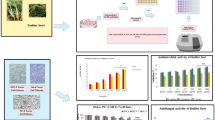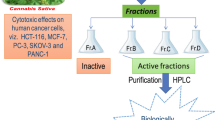Abstract
A new triterpenoid, 20(R),22(ξ),24(S)-dammar-25(26)-ene-3β,6α,12β,20,22,24-hexanol (1), and three known triterpenoids, β-D-glucopyranoside,(3β,12β)-12,20-dihydroxydammar-24-en-3-yl,6-acetate (2), 20(R)-ginsenoside Rg3 (3), and 20(R)-ginsenoside Rh2 (4), were isolated from the leaves of Panax ginseng. Their structures were determined by chemical analysis and spectral methods (IR, 1D and 2D NMR, HR-ESI-MS). Compounds 1–4 were exhibited various degrees of cytotoxicity in the human hepatoma cell line, HepG2. Compound 1 had the highest cytotoxic potency, with an IC50 value of 20.1 μM, by stimulating p53-mediated cell cycle arrest at the G1 to S phase transition, leading to apoptosis via activation of the caspase signaling pathway.
Similar content being viewed by others
References
Bunz, F., Dutriaux, A., Lengauer, C., Waldman, T., Zhou, S., Brown, J. P., Sedivy, J. M., Kinzler, K. W., and Vogeistein, B., Requirement for p53 and p21 to sustain G2 arrest after DNA damage. Science, 282, 1497–1501 (1998).
Chen, Y. J., Su, S. X., Ma, Q. F., Pei, Y. P., and Yao, X. S., Studies on new minor saponins isolated from leaves of Panax ginseng C. A. Meyer. Acta pharmaceutica sinica, 22, 685–689 (1987).
Ciciarello, M., Mangiacasale, R., Casenghi, M., Limongi, M. Z., D’Angelo, M., Soddu, S., Lavia, P., and Cundari, E., p53 displacement from centrosomes and p53-mediated G1 arrest following transient inhibition of the mitotic spindle. J. Biol. Chem., 276, 19205–19213 (2001).
Dou, D. Q., Chen, Y. J., Liang, L. H., Pang, F. G., Shimizu, N., and Takeda, T., Six new dammarane-type triterpene saponins from the leaves of Panax ginseng. Chem. Pharm. Bull., 49, 442–446 (2001).
Feng, B. S., Wang, X. B., and Wang, D. Q., Studies on dammarane-type triterpene saponins from the leaves of Panax japonicus C.A. Meyer var. major (Burk.) C.Y.Wu et Feng collected in Qinling. Acta Bot Yunnan, 9, 477–484 (1987).
Haupt, S., Berger, M., Goldberg, Z., and Haupt, Y., Apoptosis-the p53 network. J. Cell. Sci., 116, 4077–4085 (2003).
Hill, P. A., Tumber, A., and Meikle, M. C., Multiple extracellular signals promote osteoblast survival and apoptosis. Endocrinology, 138, 3849–3858 (1997).
Hu, H. B., Ahn, N. S., Yang, X. L., Lee, Y. S., and Kang, K. S., Ganoderma lucidum extract induces cell cycle arrest and apoptosis in MCF-7 human breast cancer cell. Int. J. Cancer, 102, 250–253 (2002).
Kastan, M. B., Onyekwere, O., Sidransky, D., Vogelstein, B., and Craig, R. W., Participation of p53 protein in the cellular response to DNA damage. Cancer Res., 51, 6304–6311 (1991).
Kawazoe, N., Watabe, M., Masuda, Y., Nakajo, S., and Nakaya, K., Tiamil is involved in the regulation of bufalin-induced apoptosis in human leukemia cells. Oncogene, 18, 2413–2421 (1999).
Kim, S. O. and Han J., Pan-caspase inhibitor zVAD enhances cell death in RAW246.7 macrophages. J. Endotoxin. Res., 7, 292–296 (2001).
Kitagawa, I., Yoshikawa, M., Yoshihara, N., Hayashi, T., and Taniyama, T., Chemical studies on crude drug precession. I. On the constituents of Ginseng Radix Rubra (I). Yakugaku Zasshi, 103, 612–622 (1983).
Lane, D. P., p53 guardian of the genemo. Nature, 358, 15–16 (1992).
Lee, J. H., Kang, G. H., Kim, K. C., Kim, K. M., Park, D. I., Choi, B. T., Kang, H. S., Lee, Y. T., and Choi, Y. H., Tetrandrine-induced cell cycle arrest and apoptosis in A549 human lung carcinoma cells. Int. J. Oncol, 21, 1239–1244 (2002).
Ma, S. G., Jiang, Y. T., Song, S. J., Wang, Z. H., Bai, J., Xu, S. X., and Lu, K., Alkaline-degradation products of ginsenosides from leaves and stems of Panax quinquefolium. Acta pharmaceutica sinica., 40, 924–930 (2005).
Marchenko, N. D., Zaika, A., and Moll, U. M., Death signal-induced localization of p53 protein to mitochondria. A potential role in apoptotic signaling. J. Biol. Chem., 275, 16202–16212 (2000).
Miyashita, T. and Reed, J. C., Tumour suppressor p53 is a direct transcriptional activator of human bax gene. Cell, 80, 293–299 (1995).
Mizukami, S., Kikuchi, K., Higuchi, T., Urano, Y., Mashima, T., Tsuruo, T., and Nagano, T., Imaging of caspase-3 activation in HeLa cells stimulated with etoposide using a new fluorescent probe. FEBS Lett., 453, 356–360 (1999).
Nicholson, D. W., Ali, A., Thornberry, N. A., Vaillancourt, J. P., Ding, C. K., Gallant, M., Gareau, Y., Griffin, P. R., Labelle, M., and Mazebnik, Y. A., Identification and inhibition of the ICE/CED-3 protease necessary for mammalian apoptosis. Nature (London), 376, 37–43 (1995).
Qiu, F., Ma, Z. Z., Pei, Y. P., Xu, S. X., Yao, X. S., and Chen, Y. J., Studies on Chemical Constituents of Flower-buds of Panax ginseng C. A. Meyer. Chin. J. Med. Chem., 8, 205–207.
Rongwei, T., Chingseng, A., and David, M., Regioselective acylation of ginsenosides by Novozym435. Tetrahedron Letters, 44, 5661–5664 (2003).
Waldman, T., Kinzler, K. W., and Vogelstein, B., p21 is necessary for the p53-mediated G1 arrest in human cancer cells. Cancer Res., 55, 5187–5190 (1995).
Wang, X. W., Zhan, Q., Coursen, J. D., Khan, M. A., Kontny, H. U., Yu, L., Hollander, M. C., O’Connor, P. M., Fornace, A. J., and Harris, C. C., GADD45 induction of a G2/M cell cycle checkpoint. Proc. Nat. Acad. Sci., 96, 3706–3711 (1999).
Yang, X. W., Complete assignment of 1H and 13C NMR chemical shifts of 20(R)-ginsenoside Rg2 and 20(S)-ginsenoside Rg2. Chinese J. Magn. Reson., 17, 9–15 (2000).
Zhou, N. N., Zhu, X. F., Zhou, J. M., Li, M. Z., Zhang, X. S., Huang, P., and Jiang, W. Q., 2-Methoxyestradiol induces cell cycle arrest and apoptosis of nasopharyngeal carcinoma cells. ACTA PHARMACOL. SIN., 25, 1515–1520 (2004).
Zhu, H. S., Yang, X. L., Wang, L. B., Zhao, D. X., and Chen, L., Effects of extracts from sporoderm-broken spores of Ganoderma lucidum on Hela cells. Cell. Biol. Toxicol., 16, 201–206 (2000).
Author information
Authors and Affiliations
Corresponding author
Rights and permissions
About this article
Cite this article
Huang, J., Tang, Xh., Ikejima, T. et al. A new triterpenoid from Panax ginseng exhibits cytotoxicity through p53 and the caspase signaling pathway in the HepG2 cell line. Arch. Pharm. Res. 31, 323–329 (2008). https://doi.org/10.1007/s12272-001-1159-8
Received:
Published:
Issue Date:
DOI: https://doi.org/10.1007/s12272-001-1159-8




